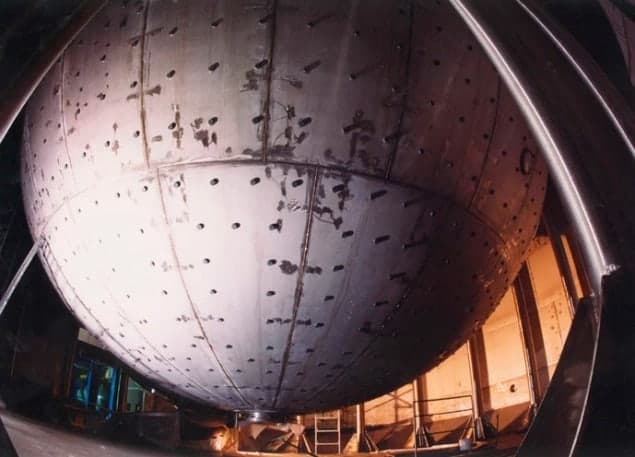
Physicists working at the Gran Sasso National Laboratory in Italy have detected electron antineutrinos created by radioactive decays within Earth’s crust and mantle. This result builds on earlier evidence for such “geoneutrinos” obtained by a Japanese experiment five years ago and paves the way to new direct measurements of processes taking place deep inside our planet.
Physicists have long studied neutrinos emitted by the Sun and created by cosmic rays entering Earth’s atmosphere. These observations have improved our understanding of solar physics and revealed that neutrinos – chargeless, extremely inert fundamental particles – have a very tiny mass. Theory also predicts that neutrinos, or more precisely electron antineutrinos, are produced inside the Earth by radioactive decay of certain nuclei. Measuring the flux of these geoneutrinos should reveal how much of the energy generated inside the Earth is due to radioactive decays and could improve our understanding of processes that rely on that energy, such as plate tectonics and generation of Earth’s magnetic field.
Detecting geoneutrinos, however, is extremely tricky. Like any kind of neutrino, their observation requires enormous volumes of detector material and a location deep underground to prevent interference from cosmic rays. But unlike higher-energy solar and atmospheric neutrinos, geoneutrinos cannot be studied via their interaction with the nuclei of heavy water, because their signal would be swamped by the radioactivity in this liquid. Instead certain kinds of hydrocarbon are used, in which passing geoneutrinos can occasionally collide with a proton to create a positron and a neutron and in so doing generate a distinctive dual gamma-ray emission, which produces detectable light.
In 2005, researchers working on the KamLAND experiment, 1 km below the surface in Japan, reported geoneutrinos in their detector. However, to do so the team had to separate the signal from a strong background of antineutrino emission produced by a number of nuclear reactors located close by (a location chosen deliberately to study reactor antineutrinos).
Very low levels of background
The Borexino experiment, however, was designed to study low-energy solar neutrinos and therefore has very low levels of background. Located 1.5 km below the surface of the Gran Sasso mountain, it is situated hundreds of kilometres away from the nearest reactor.
Neutrinos are detected in some 300 tonnes of a doped hydrocarbon called pseudocumene contained within a nylon sphere, which is immersed within 1000 tonnes of pure pseudocumene enclosed by a stainless steel sphere, which is itself surrounded by 2400 tonnes of highly purified water held within another steel container with a diameter of 18 m. All the individual components – including the detecting medium, liquids and photomultiplier tubes used to record the gamma-ray signals – were chosen to have as low a level of intrinsic radioactivity as possible.
The experiment ran for two years ending December 2009 and the Borexino collaboration (about 80 researchers from six countries) says that it detected 9.9 geoneutrino events, with uncertainties of +4.1 and –3.4. Spokesman Gianpaolo Bellini of the University of Milan says that the result also appears to rule out a controversial hypothesis that a large part of Earth’s heat is produced by a naturally occurring nuclear reactor fuelled by uranium in the planet’s core.
No evidence for a ‘georeactor’
Such a “georeactor” would emit electron antineutrinos with roughly the same spread of energies as those emitted by nuclear power stations, but the Borexino researchers found that the experiment detected roughly as many antineutrinos as would be expected from power stations alone.
Bellini says that the Borexino results provide the first real detection of geoneutrinos, and that the results obtained by KamLAND are instead an “indication”. However, KamLAND spokesman Atsuto Suzuki at Japan’s KEK laboratory sees things differently. He congratulates the Borexino collaboration on producing “beautiful” results but says there are not “any meaningful differences” between these results and a set reported by his group two years ago. “The number of observed geoneutrino events was 73 ± 27 for KamLAND in 2008 and was 9.9 ± 4.1–3.4 for Borexino,” he points out. “This tells you everything. Physicists understand whether using words such as a ‘hint’ versus an ‘observation’ is significant or not.”
Regardless of differences of interpretation, both Bellini and Suzuki agree that more data are needed. Indeed, there are a number of larger experiments currently in the planning stages, including a 10,000 tonne detector that would be attached to the Pacific Ocean floor in order to make more precise measurements of the geoneutrinos coming up from the mantle (since the crust is very thin under the Pacific).
“KamLAND and Borexino demonstrate the potential of geoneutrinos for examining terrestrial composition and radiogenic power, leading to an improved understanding of the origin and thermal evolution of our planet,” says Stephen Dye of the Hawaii Pacific University and the University of Hawaii. “Thanks to these pioneering measurements we can plan projects that look at those questions in detail.”
The work is reported at arXiv: 1003.0284 and has been submitted to Europhysics Letters B.



